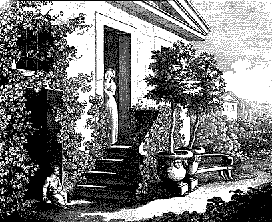 Goethe, the best-known poet of the German language, was a lover of natural beauty. An art and garden design historian introduces us to the gardens of the era of Romanticm (Romantik).
Goethe, the best-known poet of the German language, was a lover of natural beauty. An art and garden design historian introduces us to the gardens of the era of Romanticm (Romantik).
 Like many Romantics, Goethe loved untamed nature. He was one of the first poets to take romance out of the shelter of gardens. Before Goethe, romance was considered best suited to moonlit walks along garden paths and trysts in garden pavilions. It isn’t that Goethe was not interested in gardens. He was absolutely fascinated by botany and botanic collections, and he loved the unpretentious garden which he began to create in 1776, next to his Gartenhaus in Weimar. It is just that Goethe does not seem to have written much about the design of gardens.
Like many Romantics, Goethe loved untamed nature. He was one of the first poets to take romance out of the shelter of gardens. Before Goethe, romance was considered best suited to moonlit walks along garden paths and trysts in garden pavilions. It isn’t that Goethe was not interested in gardens. He was absolutely fascinated by botany and botanic collections, and he loved the unpretentious garden which he began to create in 1776, next to his Gartenhaus in Weimar. It is just that Goethe does not seem to have written much about the design of gardens.
In The Sorrows of Young Werther (1774), Goethe describes Werther’s response to a country garden: "The garden is a simple one, and the moment one enters it, one feels that it was designed not by some scientific gardener but by a feeling heart intending to take pleasure here." Many people feel that Goethe was expressing his own response to gardens in this sentence.

An engraving of Goethe’s "Hausgarten" at Weimar show an unpretentious garden. Most people would call it a cottage garden. Unlike many romantic gardens of the latter half of the eighteenth century, his garden was not cluttered with monuments and inscriptions. The only monument was a plain square cube about 3 feet by 3 feet (1 metre by 1 metre), which was surmounted by a plain stone sphere; Goethe called this his "Altar of Good Fortune."
Goethe’s first exposure to a garden in the English landscape style occurred in the spring of 1778, when he visited Wörlitz Park. That park had been created between 1765 and 1817 by Prince Franz von Anhalt-Dessau and his gardeners Eyserbeck, Schoch and Neumark. This was the first landscape garden created in Germany. Both Prince Franz and J.F. Eyserbeck had visited England and were strongly influenced by the gardens at Claremont, Stowe, and Stourhead. It differed from English gardens in that the part of the park which has always been called the "neue Garten" (New Garden, begun in the mid 1780s and completed in 1796) was strongly influenced by the gardens of southern Italy. The "neue Garten" was the work of J.G. Schoch, and its style is usually called sentimental or sentimental-romantic. It contains a large number of canals, features which are almost never found in English landscape gardens of the eighteenth century.
It was the more picturesque of the English landscape gardens which continental Europe embraced and imitated in their English style gardens. This was encouraged by the writings of C. L. Hirschfeld. He was a professor of aesthetics at Kiel University> His five volume Theorie der Gartenkunst (Theory of Garden Art) was very influential in the spread of the English landscape style to Scandinavia and the German speaking countries. Along with many Romantics, he felt that garden art should awaken feelings of sorrow, happiness, or surprise in visitors. The gardens which he promoted were closer to the French "jardins anglo-chinois" than to the landscape gardens of Capability Brown.
Goethe is known to have been influenced by Hirschfeld and he fell in love with the Elysian mood of the garden at Wörlitz. In later years he seems to have felt that this mood was spoiled by the large numbers of buildings which were erected in the garden. This flaw is characteristic of many continental gardens in the English landscape style, and it would be a flaw in many of the landscape gardens of England if all of their follies were still standing. The best English landscape gardens were simple compositions of lawn, trees, and water, with one or two classical buildings carefully placed. It was always tempting to add additional stimulation by constructing exotic buildings and artificial ruins.
This is all that I have learned about Goethe’s taste in garden design. I have read that in his 1809 novel Die Wahlverwandtschaften (Elective Affinites), Goethe carefully described the tastes of the hero and heroine as a way of showing their different personalities, but I have not been able to find a translation of this novel on the Internet. It would have been much easier to write about Goethe’s interest in botany. Goethe was involved in selecting rare plants for Weimar’s Belvedere garden, and he was seriously involved in the effort which Carl Linnaeus (1707 - 1778) led to achieve an adequate classification of plants. In 1816, Goethe wrote of Linnaeus, "Apart from Shakespeare and Spinoza, I know of no other master from the past who has so impressed me."
© 1999 Kirk Johnson


